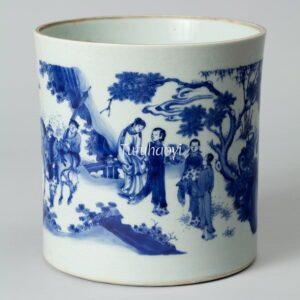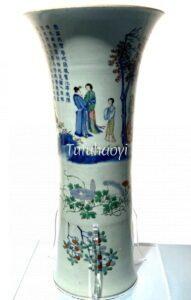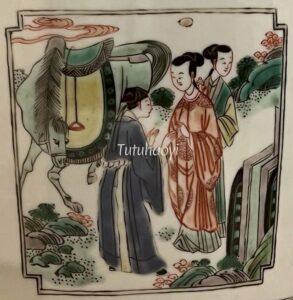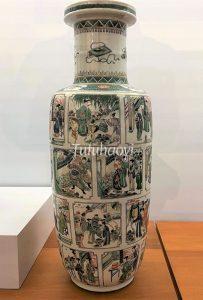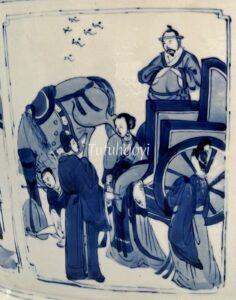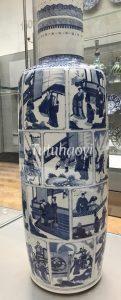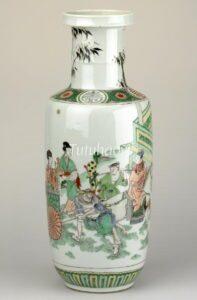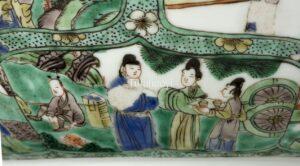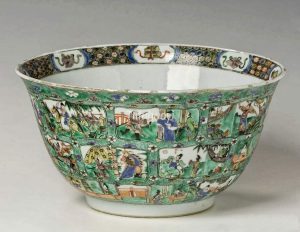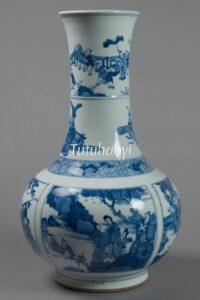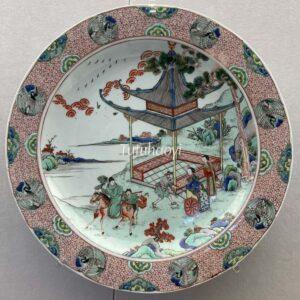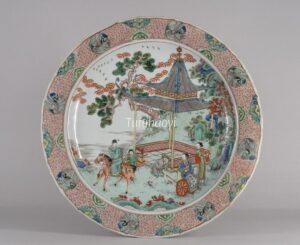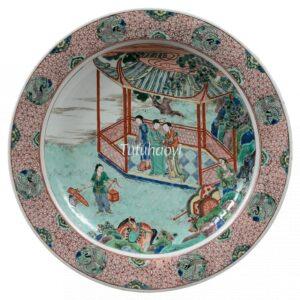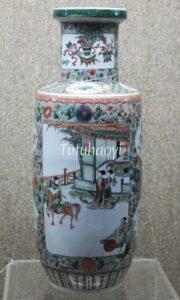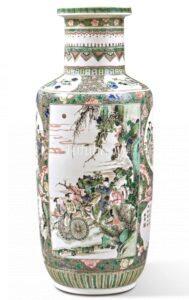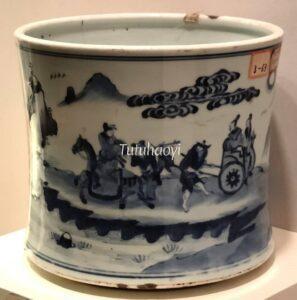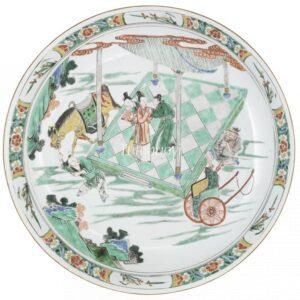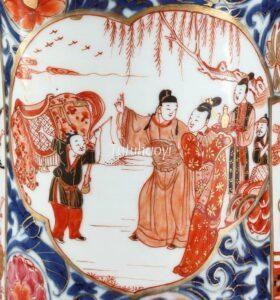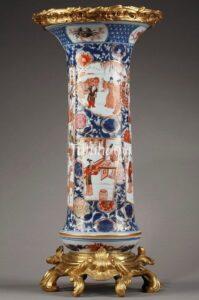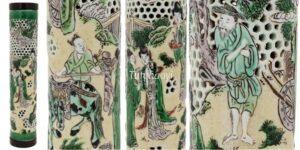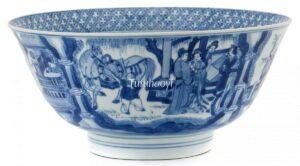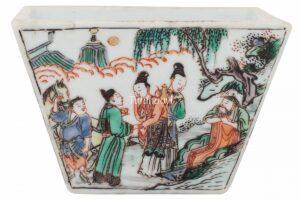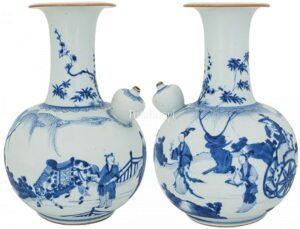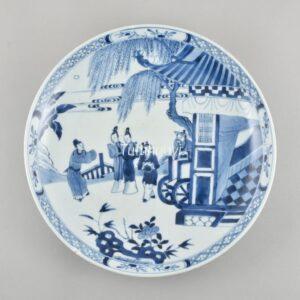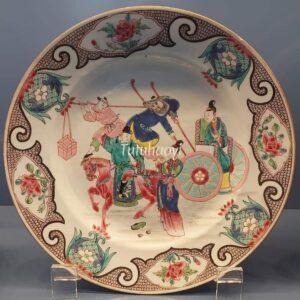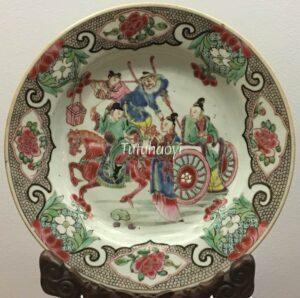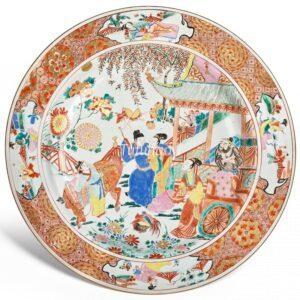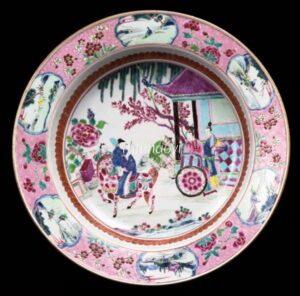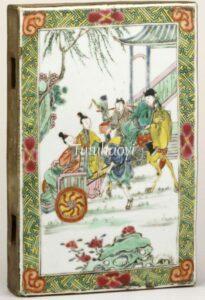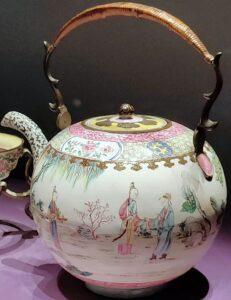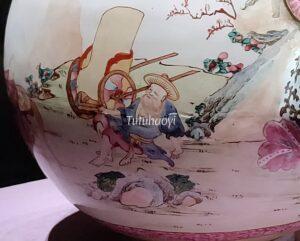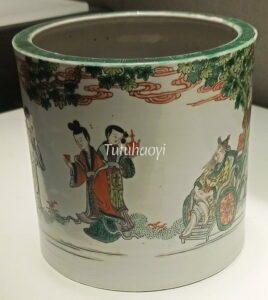Farewell feast at the pavilion
长亭送别 (哭宴)
© Tutuhaoyi.com owns the copyright of the description content for the images attached. Quoting all or part of the description content on this page is permitted ONLY IF ‘Tutuhaoyi.com’ is clearly acknowledged anywhere your quote is produced unless stated otherwise. (本页描述内容版权归Tutuhaoyi.com所有,转发或引用需注明 “Tutuhaoyi.com”, 侵权必究, 已注开源信息的条目除外。)
This is Scene three of Act Four of The Romance of the Western Chamber (Xixiang Ji 西厢记), a famous Chinese drama written by playwright Wang Shifu 王实甫 (1250–1336) in Yuan dynasty.
Zhang Gong 张珙 (styled Junrui 君瑞, also known as Scholar Zhang), and Madame Cui’s daughter, Cui Yingying 崔莺莺, were deeply in love with each other. (Refer to Consummation of Love.) However, Madame Cui insisted that Scholar Zhang travel to the capital to sit the imperial examination, declaring that only upon achieving official recognition could he return to marry her daughter. Thus, a group of people accompanied Scholar Zhang to a pavilion in the countryside to bid him farewell as he embarked on his journey to the capital.
Zhang Sheng’s horse moved slowly, while Yingying’s carriage hurriedly followed behind. Yingying lamented, saying,
Beneath the azure, cloudy sky,
Golden blooms spread far and wide.
The west wind blows, geese southward stray,
From the north, they wing away.
Who dyes the frosted woods at dawn,
With drunken hues so brightly drawn?
It’s the tears of those who part,
Falling from a longing heart.
(碧云天, 黄花地, 西风紧, 北雁南飞
晓来谁染霜林醉? 总是离人泪)
Madame Cui ordered Hongniang 红娘 to fetch wine, instructing Yingying to offer the cup to Scholar Zhang. After drinking, Scholar Zhang sighed, ‘I have experienced the bitterness of longing these past days, but now I realise that the sorrow of parting is tenfold greater.’
Yingying urged Scholar Zhang to take care of himself. In return, Scholar Zhang vowed his unwavering devotion, declaring, ‘Who in this world could compare to you, my lady? Beyond you, Zhang Gong could never love another.’
At last, the moment of parting arrived. Scholar Zhang and Yingying exchanged tender farewells before setting off on their separate paths, their hearts heavy with longing and hope.
Story scene description by Rachel Ma
See all episodes in the Romance of the Western Chamber
Other figural stories on Chinese artworks:
The dream by the Qiantang River 钱塘梦
Fig 1: porcelain brush pot with underglaze blue decoration, Chongzhen period (1628–44), Ming dynasty, courtesy of Museum of East Asian Art, Cologne, Germany
Fig 2: porcelain Gu vase with underglaze blue and overglaze enamelled decoration, Shunzhi period (1644–61), Qing dynasty, courtesy of the Shanghai Museum, China
Fig 3-4: rouleau vase with overglaze enamelled decoration, Kangxi period (1662–1722), Qing dynasty, courtesy of The Guimet Museum, Paris; Photograph by Riad Kneife
Fig 5-6: rouleau vase with underglaze blue decoration, Kangxi period (1662–1722), Qing dynasty, courtesy of the Victoria & Albert Museum, London; Photograph by JP Kim
Fig 7: famille verte rouleau vase, Kangxi period (1662–1722), Qing dynasty, courtesy of the Trustees of the British Museum
Fig 8-9: porcelain bowl of a set with overglaze enamelled decoration, Kangxi period (1662–1722), Qing dynasty, courtesy of Groninger Museum, Groningen, The Netherlands
Fig 10: porcelain vase with underglaze blue decoration, Kangxi period (1662–1722), Qing dynasty, courtesy of the Metropolitan Museum of Art, New York
Fig 11: famille verte porcelain dish, Kangxi period (1662–1722), Qing dynasty, courtesy of Ariana Museum, Geneva
Fig 12: famille verte porcelain dish, Kangxi period (1662–1722), Qing dynasty, courtesy of lot-art.com, sold on 3 Jun 2021, New York, Lot 0071
Fig 13: famille verte porcelain dish, Kangxi period (1662–1722), Qing dynasty, courtesy of 1stdibs.com, sold in Paris, France, Reference Number: 1stDibs: LU2629310671953
Fig 14: famille verte rouleau vase, Kangxi period (1662–1722), Qing dynasty, courtesy of Tibet Museum, China
Fig 15: famille verte rouleau vase, Kangxi period (1662–1722), Qing dynasty, courtesy of Sotheby’s auction house, New York, 21 April 2023, Lot 703
Fig 16: porcelain brush holder with underglaze blue decoration, Kangxi period (1662–1722), Qing dynasty, courtesy of Wuhan Museum, Hubei Province, China
Fig 17: famille verte porcelain charger, Kangxi period (1662–1722), Qing dynasty, courtesy of Christie’s auction house, London, 20 Feb 2020, Lot 40
Fig 18-19: gilded porcelain vase with underglaze blue and overglaze enamelled decoration, Kangxi period (1662–1722), Qing dynasty, courtesy of Bertrand de Lavergne collection
Fig 20: porcelain incense holder with overglaze enamelled decoration, Kangxi period (1662–1722), Qing dynasty, courtesy of the Jie Rui Tang Collection, No. 0055
Fig 21: porcelain bowl with underglaze blue decoration, Kangxi period (1662–1722), Qing dynasty, courtesy of the Jie Rui Tang Collection, No. 0388
Fig 22: famille verte porcelain container, Kangxi period (1662–1722), Qing dynasty, courtesy of the Jie Rui Tang Collection, No. 0357
Fig 23: porcelain Junchi vase with underglaze blue decoration, Kangxi period (1662–1722), Qing dynasty, courtesy of the Jie Rui Tang Collection, No. 0249
Fig 24: porcelain dish with underglaze blue decoration, Kangxi period (1662–1722), Qing dynasty, courtesy of Galerie Nicolas Fournery, Paris
Fig 25: famille rose porcelain plate, Yongzheng period (1723–35), Qing dynasty, courtesy of Munich Residence Palace, Germany; Photograph by Jason Ooi
Fig 26: famille rose porcelain plate, Yongzheng period (1723–35), Qing dynasty, courtesy of The Guimet Museum, Paris
Fig 27: rose-verte porcelain charger, Yongzheng period (1723–35), Qing dynasty, courtesy of Bonhams auction house, New York, 24 January 2023, Lot 42
Fig 28: famille rose porcelain basin, Yongzheng period (1723–35), Qing dynasty, courtesy of Cohen & Cohen, publications Think Pink! January 2013
Fig 29: famille verte porcelain tile, Qianlong period (1736-95), Qing dynasty, courtesy of the Trustees of the British Museum
Fig 30-31: falangcai enamelled kettle, Qianlong period (1736–95), Qing dynasty, courtesy of the Chinese University of Hong Kong Art Museum; Photograph by Rachel Ma
Fig 32: porcelain brush holder with overglaze enamelled decoration, the Republic Period (1912–49), courtesy of China Ceramic Museum, Jingdezhen, Jiangxi, China; Photograph by Zhou Yinghui 周迎辉
